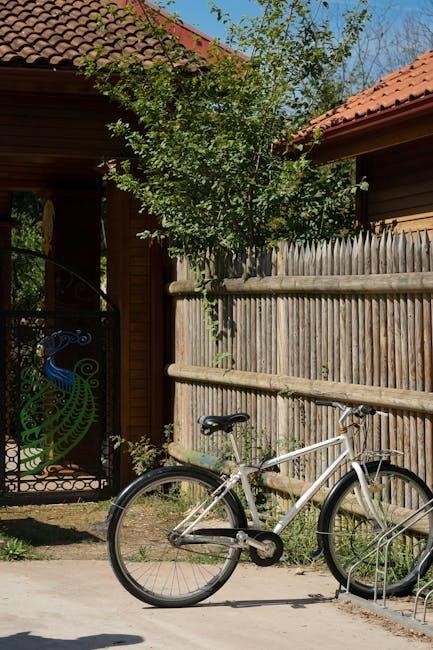Sliding gates provide a practical and modern solution for securing properties, combining durability with sleek design. They utilize guide rails and rollers for smooth operation, enhancing security and accessibility while offering versatile installation options for various settings.
1.1 What Are Sliding Gates?
Sliding gates are gates that open horizontally by sliding along a guide rail. They typically use rollers or wheels attached to the gate posts for smooth movement. These gates are commonly used in both residential and commercial settings because they are space-efficient and can be designed to fit various architectural styles. They often incorporate durable materials like steel or nylon for longevity and performance, making them a practical choice for secure and accessible entry points.
1.2 Benefits of Sliding Gates Over Other Types
Sliding gates are highly space-efficient, making them ideal for properties with limited room. They offer enhanced security with features like anti-crush mechanisms and tamper-proof locks. Durable materials and smooth operation ensure longevity, while automation options provide convenience. Their customizable design allows for aesthetic flexibility, making them suitable for both modern and traditional settings while maintaining reliability and accessibility.

Types of Sliding Gates
Sliding gates come in manual and automated designs, offering versatility for various needs. Cantilever gates operate without ground tracks, while wheeled gates use rollers on a rail system, ensuring smooth and reliable functionality.
2.1 Manual vs. Automated Sliding Gates
Manual sliding gates require physical effort to open and close, making them cost-effective and simple to install. Automated gates, however, offer convenience and enhanced security with remote control or sensor activation, reducing manual labor and providing seamless access. Both options cater to different preferences and budgets, ensuring functionality and durability.
2.2 Cantilever vs. Wheeled Sliding Gates
Cantilever sliding gates operate without touching the ground, supported by a beam and rollers, ideal for uneven surfaces. Wheeled gates use wheels on a track, offering smoother operation and less strain on the gate. Both designs ensure efficient functionality, but cantilever gates are preferred for heavy-duty applications and challenging terrains, while wheeled gates suit standard installations for ease of use.

Materials and Construction
Sliding gates are crafted from durable materials like steel, aluminum, and wood, ensuring longevity. Robust construction with electrogalvanized steel and nylon rollers enhances performance and withstands various environmental conditions effectively.
3;1 Common Materials for Sliding Gates
Sliding gates are typically made from durable materials such as steel, aluminum, and wood. Steel offers strength and security, while aluminum is lightweight and corrosion-resistant. Wood provides an aesthetic appeal, often used for traditional designs. These materials ensure the gate’s longevity and performance, catering to various architectural styles and environmental conditions effectively.
3.2 Importance of Durable Hardware Components
Durable hardware components are essential for the smooth operation and longevity of sliding gates. High-quality guide rails, rollers, and bearings minimize friction and wear, ensuring efficient movement. Electrogalvanized steel and nylon rollers offer rust resistance and silent operation, while reinforced brackets provide stability. These components are crucial for maintaining the gate’s performance and safety over time, even under heavy use.

Hardware Components for Sliding Gates
Essential components like guide rails, rollers, and bearings ensure smooth operation. Durable materials, such as electrogalvanized steel and nylon, enhance longevity and functionality for reliable gate performance.
4.1 Guide Rails and Rollers
Guide rails and rollers are critical for smooth sliding gate operation. Made from durable materials like electrogalvanized steel and nylon, they ensure longevity and effortless movement. The guide rail is typically welded to the gate frame, while rollers attach to the gate and glide along the rail, minimizing friction and wear.
4.2 Bearings and Wheels for Smooth Operation
Bearings and wheels are essential for ensuring the smooth operation of sliding gates. High-quality nylon wheels and robust bearings reduce friction and wear, allowing the gate to move effortlessly along the guide rail. Durable materials and precise engineering ensure long-lasting performance, even under heavy use, making them a vital component for reliable gate functionality.

Installation Guide
Proper installation ensures smooth functionality and durability. Prepare the site, align guide rails, and securely fasten hardware. Follow step-by-step instructions for precise fitting and adjustment to guarantee optimal performance.
5.1 Preparing the Site for Sliding Gate Installation
Ensure the site is clear of debris and obstructions. Check the ground for levelness and stability. Mark the gate’s path accurately, considering posts and track alignment. Verify all materials and hardware are ready. Proper preparation ensures a smooth and efficient installation process, preventing future issues and ensuring safe operation of the sliding gate system.
5.2 Step-by-Step Installation Process
Begin by securing the posts and aligning the track system. Attach the rollers to the gate frame and ensure they fit the guide rails. Mount the gate frame on the track, making sure it slides smoothly. Install the motor and control systems if automating. Test the gate’s operation, checking for proper alignment and functionality. Secure all connections and finalize the setup for reliable performance.

Maintenance and Repair
Regular lubrication of rollers and bearings ensures smooth operation. Inspect guide rails for alignment and damage, addressing issues promptly to prevent gate malfunction and extend system longevity.
6.1 Regular Maintenance Tips
Regular maintenance is crucial for optimal sliding gate performance. Lubricate rollers and bearings with high-quality grease to reduce friction and prevent wear. Inspect guide rails for alignment and damage, ensuring they are securely fastened. Clean tracks and wheels from debris to avoid obstructions. Schedule annual professional inspections to address potential issues early, ensuring smooth operation and longevity of the system.
6.2 Common Issues and Solutions
Common sliding gate issues include misalignment, noisy operation, and sticking rollers. Misalignment can be corrected by adjusting guide rails and ensuring proper leveling. Noisy operation often results from worn or unlubricated bearings, which should be replaced or greased. Sticking rollers may require cleaning or replacement of nylon wheels. Regular inspections and timely repairs prevent major breakdowns, ensuring smooth gate functionality and extending system lifespan.

Automation Options
Automation enhances sliding gate functionality with electronic systems, offering smooth operation and remote control. Solar-powered and hardwired options provide reliable access, improving security and convenience for users.
7.1 Electronic Automation Systems
Electronic automation systems offer seamless control and enhanced security for sliding gates. These systems integrate sensors, motors, and control panels for smooth operation. They enable remote control access, automatic opening/closing, and advanced safety features. Modern systems often include timers, obstacle detection, and battery backup options, ensuring reliable performance. They are compatible with various gate types and sizes, making them versatile for residential or commercial use.
7.2 Solar-Powered vs. Hardwired Systems
Solar-powered systems offer eco-friendly automation, ideal for remote areas with limited electricity access. They rely on solar panels and batteries, reducing operational costs. Hardwired systems, while more reliable and durable, require professional installation and a power source. Solar-powered systems are flexible and cost-effective, while hardwired systems ensure continuous operation in urban settings. Both cater to different needs, providing efficient gate automation solutions.

Safety Features
Sliding gates incorporate essential safety features like anti-crush mechanisms and tamper-proof locking systems to ensure secure and reliable operation, protecting users from potential hazards and unauthorized access.
8.1 Anti-Crush Safety Mechanisms
Anti-crush mechanisms are vital for sliding gates, preventing accidents by detecting obstacles. These systems use sensors or pressure-sensitive edges to halt or reverse gate movement, ensuring user safety. They are especially crucial in automated gates, where continuous motion could pose risks; Proper installation and regular maintenance of these mechanisms are essential to uphold their effectiveness and reliability over time.
8.2 Tamper-Proof Locking Systems
Tamper-proof locking systems enhance sliding gate security, preventing unauthorized access. Constructed from durable materials, these locks feature secure fixation points and anti-pick mechanisms. They integrate seamlessly with automated gates, offering remote control compatibility. Advanced designs include reinforced housings and anti-cut plates, ensuring long-lasting protection against vandalism and forced entry, thereby safeguarding properties with reliable and high-security solutions.

Design Considerations
Sliding gates offer space-saving solutions and aesthetic appeal, blending functionality with modern design. Durable materials like steel ensure longevity, while customizable styles cater to diverse property requirements seamlessly.
9.1 Aesthetic Design Options
Sliding gates offer versatile aesthetic options, blending seamlessly with modern or traditional designs. Materials like steel allow for sleek, minimalist looks, while customizable finishes and decorative accents enhance visual appeal. Whether for residential or commercial use, these gates can be tailored to complement property architecture, ensuring both functionality and visual harmony. Their space-saving design also preserves yard aesthetics, making them a practical yet stylish choice.
9.2 Space-Saving Design Solutions
Sliding gates are ideal for properties with limited space, as they don’t require swing room. Cantilever systems eliminate the need for ground tracks, making them perfect for driveways or pathways. Their sleek, linear design maximizes space while providing secure access. This solution is especially beneficial for urban settings or narrow entrances, offering convenience without compromising on style or functionality.

Troubleshooting Common Problems
Common issues include sticking or noisy gates, often due to worn rollers or misaligned guide plates. Regular lubrication and adjustments can resolve these problems effectively.
10.1 Identifying and Fixing Gate Misalignment
Gate misalignment occurs when the gate doesn’t glide smoothly along its track, often due to uneven ground or loose hardware. To fix this, inspect the guide rails and rollers, ensuring they are properly aligned and securely fastened. Adjust or replace worn components, and check for obstructions. Lubricating moving parts can also restore smooth operation and prevent further misalignment issues.
10.2 Addressing Noisy or Sticking Gates
Noisy or sticking gates are often caused by worn rollers, lack of lubrication, or debris on the guide rails. Regularly clean the tracks and apply silicone-based lubricant to moving parts. Inspect and replace damaged rollers or bearings to ensure smooth operation. Proper alignment and maintenance can prevent these issues, ensuring your sliding gate functions quietly and efficiently over time.